Gov. Tim Walz harvests 2 roosters at
2022 Governor's Pheasant Hunting Opener

Gov. Tim Walz, Lt. Gov. Peggy Flanagan and DNR staff celebrated the 10th annual Governor's Pheasant Hunting Opener in Worthington Oct. 14-16.
“As a lifelong hunter and Pheasants Forever member, I look forward to this weekend all year,” said Walz, who harvested two roosters while hunting during the event. “Thank you to the community of Worthington and Nobles County for making the opening weekend of the pheasant hunting season a memorable one. I’m grateful for the Nobles County Pheasants Forever chapter for their outstanding conservation work that makes this sport possible, and the many community volunteers that helped make this celebration happen.”
The weekend also included a public lands celebration, community food truck gathering, hunters' breakfast, and a post-hunt lunch and bird cleaning.
“Hunting in Worthington and Nobles County is always memorable, and this year’s Governor’s Pheasant Hunting Opener made it even more so with the dedication of 295 additional acres to the Ransom Ridge Wildlife Management Area,” DNR Commissioner Sarah Strommen said. “I’m grateful for the many community volunteers and partners who worked so hard to make this a terrific event, and also to the hunters who came out and hunted on the area’s incredible public land.”
Gov. Walz also announced the 2023 Gov's Pheasant Hunting Opener will be in Owatonna.
Check out these photos from the celebration:
 From left: DNR Assistant Commissioner Bob Meier, Meier's dog Max and Gov. Tim Walz get ready to hunt at the 2022 Governor's Pheasant Hunting Opener.
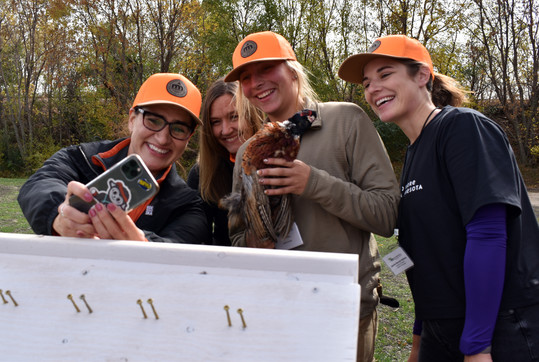 Lt. Gov. Peggy Flanagan takes a selfie with her hunting party ahead of the 2022 Governor's Pheasant Hunting Opener.
 DNR Commissioner Sarah Strommen speaks at an event during the 2022 Governor's Pheasant Hunting Opener.
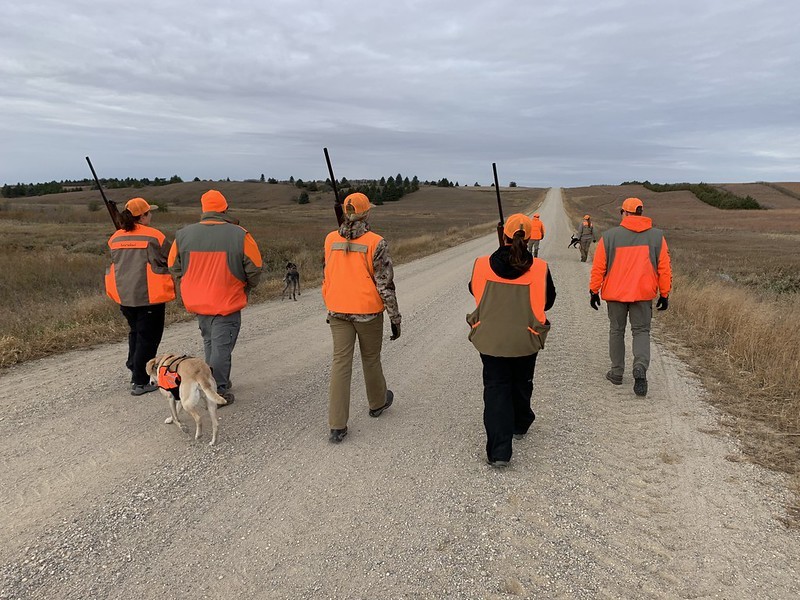 Hunters head into the field to search for pheasants during the 2022 Governor's Pheasant Hunting Opener.
4 The Outdoors report now available

The Future Funding Framework has a new name – 4 The Outdoors – and the report is now available on DNR’s website. This report summarizes the findings from the DNR's exploration into the future of conservation and outdoor recreation in Minnesota. The project aimed to identify a vision and framework for conservation and outdoor recreation funding in the state, in collaboration with a diverse cross-section of Minnesotans.
The “4 The Outdoors” report reflects the input from DNR staff and the public about:
- the current state of conservation and outdoor recreation in Minnesota,
- a vision for the future of conservation and outdoor recreation in Minnesota, and
- the steps the DNR can take to make progress toward the vision.
Specifically, the report highlights four key areas of action that will allow the DNR to achieve the vision for outdoor recreation and conservation in Minnesota. These areas of action are:
- optimize the use of current funding
- explore use and application of fees
- increase opportunities for direct support
- secure stable and predictable base and operational funding.
The work to complete all four actions is anticipated to happen on a four-year timeline, however, work toward the vision will start in the next several months as the DNR builds momentum to make significant progress over four years. During that time, the DNR will continue to work with our staff and other Minnesotans to build a system that benefits Minnesotans today and in the future.
This framework builds on the efforts that were launched through division-specific initiatives over the last decade, particularly in Fish and Wildlife and Parks and Trails. Thanks to all the staff who joined small group discussions, shared their existing research, or posted ideas on the staff Engage with DNR page. DNR staff can continue to share thoughts and questions with project manager Vanessa Perry.
Together, our efforts are building toward a stronger future for our work on behalf of Minnesotans.

Hooked on fish art
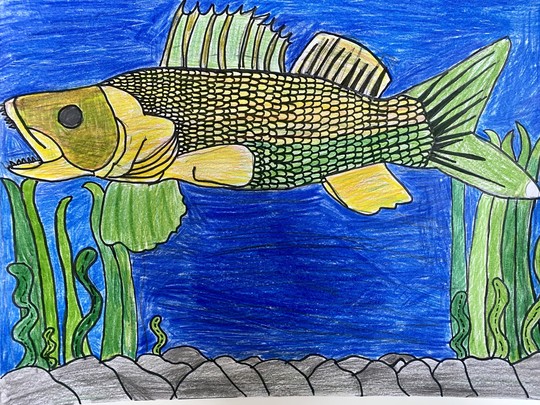 Courtesy of Wildlife Forever.
By Chris Clayton, editor-in-chief, Minnesota Conservation Volunteer
Last May, the Minnesota Conservation Volunteer wrapped up the 2022 Minnesota Fish Art Contest, hosted in partnership with White Bear Lake nonprofit Wildlife Forever. The competition invited K-12 students from around the state to research and illustrate a fish of their choice to learn more about the underwater world, angling, and aquatic conservation. More than 100 students entered the contest and each submission was beautifully done and one of a kind.
MCV is hoping to build on the success of the 2022 competition by hosting the 2023 Minnesota Fish Art Contest, which recently opened for submissions. To compete in the contest, students must submit a digital entry form, an original illustration of a fish of their choice, and a one-page informational essay (required for grades 4-12). The submission deadline is Feb. 28, 2023.
For contest details and entry forms, visit the 2023 Fish Art Contest website. Following the submission deadline, MCV will work with a panel of judges to select the Minnesota winners from multiple grade categories. State winners will advance to a national competition.
Although the Minnesota Fish Art Contest is not open to immediate relatives of DNR employees, I encourage you to let your professional networks know about this wonderful conservation education initiative!
Minnesota Conservation Volunteer is the magazine of the DNR. Supported by reader donations, its mission is to encourage conservation and sustainable use of Minnesota’s natural resources. For more info, visit mndnr.gov/MCV or subscribe.
October is...
The Combined Charities campaign
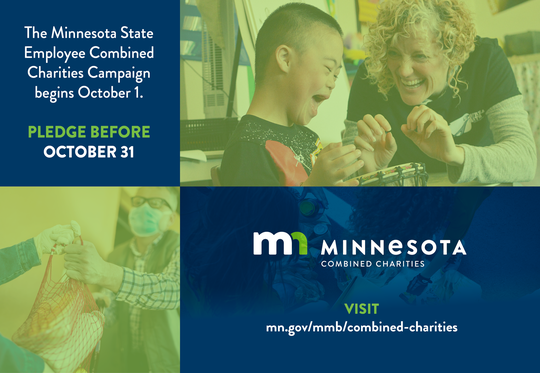
Don’t forget to help Minnesota charities, residents via payroll deduction
The Combined Charities campaign is more than halfway done! The DNR's goal for October is to get 5% of DNR employees to make a recurring payroll deduction in Self Service to support vital health, education, environmental, arts, and social service programs throughout the state.
If you have already made a deduction – thank you! If you haven't, there is still time to help the DNR reach its goal.
Though the campaign is ending, you can set up these payroll deductions in Self Service at any time. Any payroll deduction will begin in January and run through December.
To set up new or edit existing deductions:
- Go to the self-service portal (state.mn.us/employee.) and log in.
- Select “My Pay."
- Select “Charitable Deductions.” From this page, you can review, add, or update voluntary deduction information.
For more information and to learn more about participating federations, head to the State of Minnesota Combined Charities website. If you have questions, reach out to Ashley Kastner.
Cybersecurity Awareness Month

Cyber criminals want to access systems and valuable or sensitive data. Knowing the essentials and practicing good cybersecurity habits can go a long way to protect your personal information, your family and state government.
Are your passwords strong enough?
With all the world’s technological advances and cybersecurity protections, one thing remains the same: weak passwords. More than 80% of data breaches use hacked usernames or passwords, phishing attacks, errors, or misuse of information, according to the 2022 Verizon Data Breach Investigations Report.
Random password generators can create passwords of varying lengths and strengths. The longer a password, the harder it is for bad actors to guess it. Standards for the state of Minnesota require at least an 8-character password. Consider using passphrases – a series of words with added upper case, lower case, numbers, and special characters.
Password managers are a great option for securing all your passwords. Install your agency-approved password manager – KeePass or Password Safe.
- Go to the Windows start button on the taskbar.
- Search for the Software Center.
- Select Applications.
- Select a password manager and select Install.
Take time to refresh your knowledge and ensure you’re staying safe and secure online. Visit the Cybersecurity Awareness Month page for cybersecurity tips.
Disability Employment Awareness Month

ADA and Connect 700 – what’s the connection?
By Jill Westberry, ADA coordinator, Title I
October is National Disability Employment Awareness Month. NDEAM celebrates the contributions of workers with disabilities and showcases supportive, inclusive employment policies and practices. In honor of NDEAM, the DNR will be celebrating with a virtual event and live panel discussion on Tuesday, Oct. 25 from 1 – 2 p.m.
A Teams invite was sent out on Oct. 12, but please email me if you need the event invite forwarded. The event will focus on the state of Minnesota’s Connect 700 program (C700), which offers an alternative path to employment to help level the field for individuals with certain disabilities.
Research from Accenture, in partnership with Disability:IN and the American Association of People with Disabilities, reveals that companies that embrace best practices for employing and supporting more persons with disabilities in their workforce have outperformed their peers.
According to the research: “In large part, companies haven’t leveraged the talents of persons with disabilities for three reasons:
- A lack of understanding of the scope of the talent available;
- A lack of understanding of the potential benefits; and
- Misconceptions about the cost versus the return on investment of disability inclusion.
But leading companies that are working successfully toward disability inclusion have also achieved tangible financial benefits.” The upcoming NDEAM event will promote awareness of and disseminate increased knowledge of C700 to hopefully clear up any misunderstandings and bridge information gaps.
The state of Minnesota and the DNR have recognized the value of workplace inclusivity through the implementation of the C700 program and coordination under the Americans with Disabilities Act. The ADA became federal law in 1990 and prohibits discrimination against individuals with disabilities in all areas of public life, including jobs and more.
Many people have hidden disabilities and are afraid to ask for help. The ADA provides many ways that accommodations can be made to assist employees in performing their jobs to the best of their abilities. One major role of ADA coordination is ensuring that reasonable accommodation is made to all applicants and employees that are eligible. This includes C700 applicants and candidates and coordinating with each prior to their interviews and within the first week of their on-the-job trial.
A strong foundation for ascertaining the reasonableness of accommodations requires analysis of the essential work functions in a position description. ADA defines a ‘qualified individual’ as an individual who, with or without reasonable accommodation, can perform the essential functions of the employment position that such individual holds or desires.
According to employers participating in a study by Job Accommodation Network, a service from the U.S. Department of Labor’s Office of Disability Employment Policy, a high percentage (59 percent) of accommodations cost absolutely nothing to make, while the rest typically cost only $500 per employee with a disability. The success of ADA compliance and the C700 program within the DNR is contingent upon everyone (staff and supervisors) and keeping an open mind.
To learn more about the ADA coordination process, or to request accommodation contact DNR’s ADA Coordinator, Jill Westberry or visit the DNR’s ADA Intranet page. And don’t forget to tune in on Oct. 25.
Domestic Violence Awareness Month
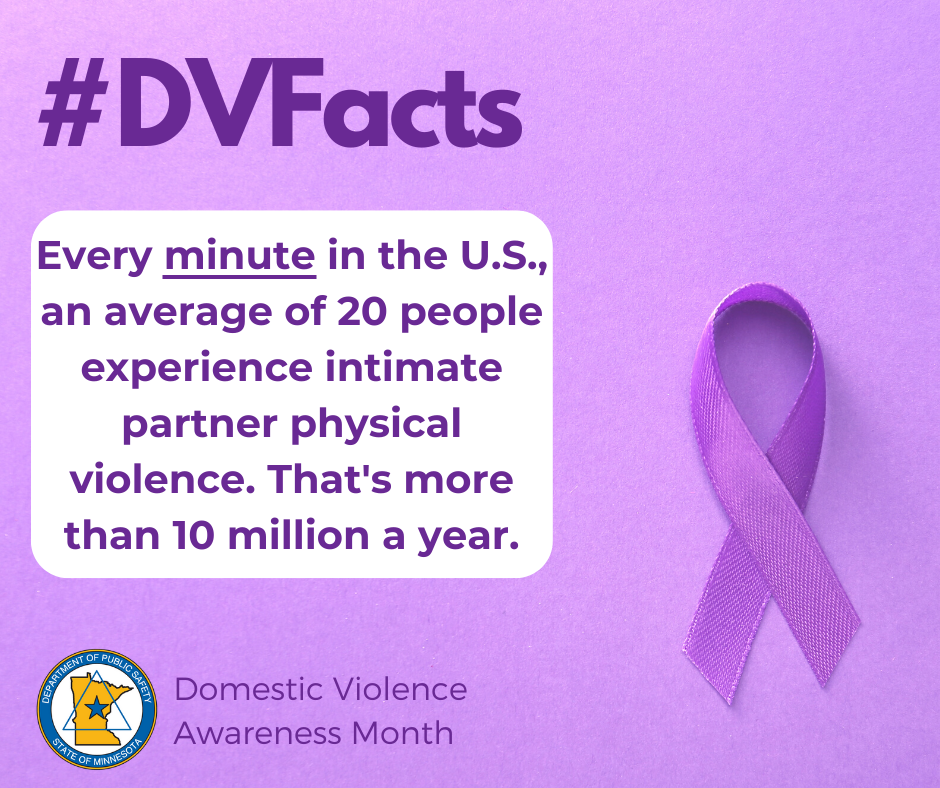
Striving for a violence-free Minnesota
Gov. Tim Walz has proclaimed October 2022 Domestic Violence Awareness Month in Minnesota.
Relationship abuse, a pattern of behavior used to gain or maintain power and control over an intimate partner, happens everywhere, including in Minnesota.
No one should have to choose between staying in an abusive relationship or finding safety. Domestic violence programs across Minnesota provide support and resources to more than 55,000 victims and survivors of domestic violence.
“Preventing violence before it begins and transforming behavior after violence occurs is essential to our shared goal of a violence-free Minnesota,” Walz said in his proclamation.
It’s important we believe and support domestic violence victims in their search for justice to empower others to come forward and bring accountability to those who commit harm.
Remember, if you or someone you know is a victim of domestic violence, help is available at DayOneServices.org or by calling 866-233-1111.

All about drought
 By Luigi Romolo, State Climatology Office
As a climatologist with the DNR, some of the most common questions I’ve been asked this year are: “How does this drought compare to last year’s drought?” or “Is it normal to have consecutive droughts?” or “Isn’t this just one long drought?”
Let’s start by comparing the drought situation of 2021 with what we are seeing this year. Perhaps the biggest difference between last year and this year is that last year the drought encompassed the entire growing season, so it had a much bigger impact on agriculture. Additionally, the drought covered most of the state for a long period of time, affecting just about every impact sector.
This year, the drought conditions have been more intense in the southern half of the state and the situation did not become serious until late summer and early fall. The two drought situations do have one thing in common — both occurred, at least in part, due to drier than normal conditions from the preceding year. The drought of 2021 really started with drier than normal conditions in the late summer and fall of 2020, while this year’s drought was preceded by the drought conditions from last year.
So is it two different droughts or one long drought? Certainly, a case can be made that last year’s drought is a different event from this year’s drought. However, when making that case, one needs to remember that a location is never more vulnerable to drought than when it first recovers from a drought. When the National Drought Mitigation Center decides to eliminate drought conditions from a given location, it doesn’t necessarily mean that the soils are now at field capacity and nor does it necessarily mean that lakes are topped off or that streams are at bankfull discharge.
What it often means is that conditions have improved just enough to say that the given location is not experiencing drought. At the point of drought condition removal, soils are typically not yet at normal levels and lakes and streams take longer to fully recover from the effects of the drought. All that being said, a case can also be made that this is one drought event that started in the summer of 2020.
Another pressing question is "what about next year?" We are starting to see drought conditions worsen across the state as precipitation shortages in the south are now rivaling what we experienced in the northern half of the state last summer. Unless the state receives abundant precipitation this fall and over the winter, drought conditions across the state are extremely likely come spring time. In the meantime, let’s hope for the best but do our best to conserve water when possible. A drop of water saved today is a drop of water for tomorrow.

Ice Safety Coordinator Nicole Biagi
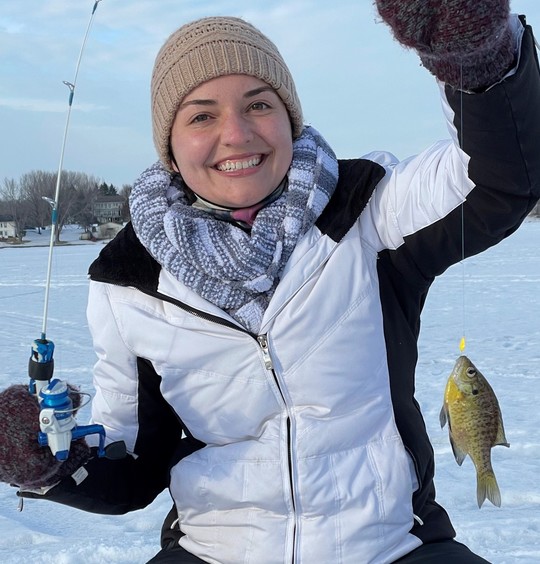 Showing the outdoors to others
By Joe Albert, Enforcement Division communications coordinator
Nicole Biagi wasn’t much different from other people who head off to college, think they’ve got their future all mapped out, and then pivot quickly in another direction.
It took her a month to realize the medical field wasn’t right for her. But she did love the outdoors, and there’s that old saying about doing something you love and never working a day in your life. Biagi decided to head down the fisheries, wildlife and conservation biology path and she's never looked back.
“For me, I feel really happy and healthy when I’m in the outdoors,” said Biagi, who grew up in St. Paul. “It brings a lot of peace and calmness. It’s really good for bringing our communities together and helping people feel good. In our world with so much technology, getting people outside is a really healthy thing.”
As the new ice safety coordinator in the Enforcement Division, helping people get outside safely, especially when it involves the ice, is at the core of her job. There have been increasing numbers of people out on the ice in recent years, and not all of them have the knowledge and skills to do it safely. Some are new to Minnesota, never having been around ice before, while others simply have decided now’s the time to cross-country ski, ice fish, skate or just take a walk on frozen water. Biagi fits into the latter group, having not really experienced being on the ice as a child. But she learned about it, and learned how to be safe on it, and eventually she was teaching it to others. Education is a big part of Biagi’s new role, and it’s one for which she’s well-equipped.
Before coming to the DNR, she spent two years with a non-profit organization doing K-12 education along the St. Croix River. Working on the ice was part of that, and Biagi led a learn-to-ice-fish program in which she focused on the importance of measuring ice thickness and empowered members of the community to safely try a new winter activity.
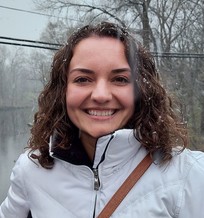
The recreational aspect is important, but even more so is helping to foster connections with the outdoors. Biagi has a minor degree in sustainability, and it’s important to her that people understand the bigger picture of a healthy environment.
“A lot of kids these days, they really don’t get outside,” she said. “It’s hard to care about the outdoors and see the negative things happening to the environment if you don’t have a connection to it by getting outside.”
As a kid, camping provided one of Biagi’s main connections to the outdoors. She, along with her dad and brother, would stay at a campground in Garrison. They’d snorkel in Mille Lacs Lake, search for agates and ride bikes on shore, and spend lots of time at the Garrison Animal Hospital, which her dad’s friends owned. There, she bottle-fed a baby beaver, fed deer fawns from a 5-gallon bucket, and released a red-tailed hawk.
All those memories from her youth created the foundation upon which she’s built her career. And in the kids and adults she’s taught, she sees that same part of herself that grew to love being outside – no matter the weather and no matter the time of year.
“It was interesting – and ultimately inspiring – how many kids would show up and say they hate being outside, or hate getting their hands dirty,” Biagi said. “One of the main activities we did involved digging through the dirt and in the water and some initially would be disgusted. But then they’d see critters in the pond, get super excited, and not want to get out of the water. The lesson is that people generally enjoy being outside and have an interest in doing it, but they may just need someone to get them started.”
|
 Name: Nicole Biagi
Work location: Central Office, Enforcement Division
Job title: Ice safety coordinator
Joined the DNR: June 2022
Education: University of Minnesota Twin Cities with a B.S. in Fisheries Wildlife and Conservation Biology and a minor in Spanish and Sustainability
Hobbies: "Most of my hobbies involve being outside and active. Growing up, I loved playing sports but thought the concept of running just to run was ludicrous. At some point in college, I decided to give running a try and have loved it ever since. It is a chance for me to get outside, clear my thoughts, and stay healthy. I also enjoy hiking, biking, camping, and gardening with native plants. Some of my indoor hobbies include drawing, painting, and rock climbing (which I hope becomes an outdoor hobby soon!)."
Something that might surprise your colleagues: "I went walleye fishing for the first time this summer up at my brother’s cabin on Lake of the Woods, and my first catch (over my lunch break) was a 26-inch walleye. I am now very excited to get back up there for ice fishing this winter with the lofty goal of breaking my record."

Mussel tossing
 Photo credit: Deb Rose
Madeline Pletta, a propagation biologist with Ecological and Water Resources, releases black sandshell mussels into the Cedar River in Austin. Black sandshell are a species of special concern in Minnesota and are one of the mussel species raised for restoration at the Center for Aquatic Mollusk Programs in Lake City.
|